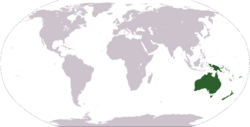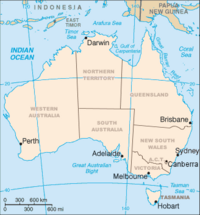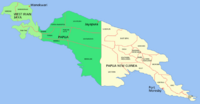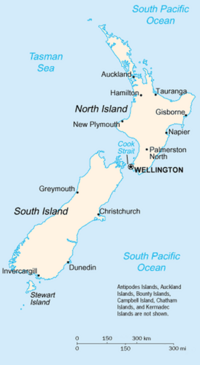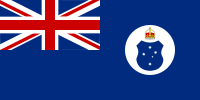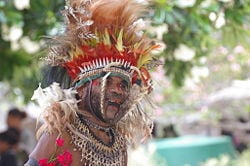Australasia
Australasia is a term used to describe a region of Oceania. The physical countries, islands or regions that comprise Australasia vary greatly, ranging from Australasia(Australia and New Zealand)[1] to Australasia, islands of the South Pacific, including Australia, New Zealand, New Guinea, and adjacent islands. The term is sometimes used to include all of Oceania (Oceania, in fact, contains four major traditions: Polynesia, Melanesia, Micronesia, and Australia.).[2] The most common and widely accepted definition for Australasia is Australia, New Zealand, and the island of New Guinea, which consist of the Indonesian provinces of Papua and Papua Barat (formerly West Irian Jaya) and the independent country of Papua New Guinea.
The term was coined by Charles de Brosses in Histoire des navigations aux terres australes (1756). He derived it from the Latin for "south of Asia" and differentiated the area from Polynesia (to the east) and the southeast Pacific (Magellanica). It is also distinct from Micronesia (to the northeast).
Physical geography
Physiographically, Australasia includes the Australian landmass (including Tasmania), New Zealand, and New Guinea. The independant country of Papua New Guinea also includes approximately 600 offshore islands.
Australia
The name "Australia" is derived from the Latin Australis, meaning "of the South". Most of Australia lies on the southern portion of the Indo-Australian Plate, flanked by the Indian Ocean to the west and the Southern Ocean to the south. Peripheral territories lie on the Eurasian Plate to the northwest, the Philippine Plate to the north, and in the Pacific Ocean – including numerous marginal seas – atop the Pacific Plate to the north and east. Australia has a total landmass of 7,686,850 square kilometer (3,074,740 square mile) on the Indo-Australian Plate, slightly smaller than the contiguous 48 states of the United States, and 25,760 kilometers (15,970 miles) of coastline. Tectonic uplift of mountain ranges or clashes between tectonic plates occurred in Australia's early history, when it was still a part of Gondwana. Much of Australia is desert or semi-arid. Only the southeast and southwest corners of the continent have a temperate climate and moderately fertile soil. The majority of Australia is desert or semi-arid erosion has heavily weathered Australia's surface, resulting it one of the flattest countries in the world. Australia also has the oldest and least fertile soils, and is the driest inhabited continent.
New Guinea
"Nueva Guinea" was the original name coined by the Spanish explorer Yñigo Ortiz de Retez in 1545. He noted the resemblance of the people to those he had seen earlier along the Guinea coast of Africa. The name was later anglacised to New Guinea.
New Guinea's landmass is about 309,000 square miles (800,000 square km). The island of New Guinea is part of the Australian Plate, known as Sahul, and once formed part of the super-continent Gondwana. Sahul separated from Antarctica about 96 million years ago after Gondwana began to break up approximately 140 million years ago. New Guinea moved into the tropics, as it drifted north. The origin of most New Guinean and Australian fauna are closely linked.
New Zealand
The name "New Zealand" originated from Dutch cartographers, who originally named the islands Nova Zeelandia, after the Dutch province of Zeeland. James Cook, the British explorer, subsequently anglicised the name to New Zealand.
New Zealand consists of two main islands, North Island and South Islands, (Te-Ika-a-Maui and Te Wai Pounamu in Māori) and a number of smaller islands. The total landmass is 268,680 square kilometres (103,738 sq mi), with approximately 15,134 km (9,404 mi) of coastline. The larger South Island is divided along its length by the Southern Alps, with Aoraki/Mount Cook at 3754 metres (12,320 ft) its highest peak. The North Island is less mountainous, but is marked by volcanism including the active Mount Ruapehu (2797 m / 9177 ft).
New Zealand is part of the continent of Zealandia which is 93% submerged and approximately half the size of Australia. Approximately 25 million years ago, a shift in plate tectonic movements pulled Zealandia apart.
Human geography
Geopolitically, Australasia is most often used as a term for Australia and New Zealand together, in the absence of another word limited to those two countries. There are many organizations whose names are prefixed with "(Royal) Australasian Society" that are limited to just Australia and New Zealand.
In the past, Australasia has been used as a name for combined Australia/New Zealand sporting teams. Examples include tennis between 1905 and 1913, when Australia and New Zealand combined its best players to compete in the Davis Cup international tournament (and won it in 1907, 1908, 1909 and 1911). Australasia also competed at the Summer Olympic Games of 1908, where they earned 1x GOLD (Rugby Union), 2 x SILVER and 2 x BRONZE medals, and again at the 1912 Summer Olympic Games, where they earned 2 x GOLD (Both Swimming), 3 x SILVER and 3 x BRONZE medals.
Anthropologists, although disagreeing on details, generally support theories that call for a Southeastern Asian origin of indigenous island peoples in Australasia and neighboring subregions.
The first human habitation of Australia is estimated to have occurred between 42,000 and 48,000 years ago.[3] These first Australians were the current Indigenous Australians (Aborigines) ancestors. They were mostly hunter-gatherers and arrived via land bridges and short sea-crossings from present-day South-East Asia.
Ecological geography
The Australasian ecozone is an ecological region that is coincident, but not synonymous (by some definitions), with the geographic region of Australasia. The ecozone includes Australia, the island of New Guinea (including Papua New Guinea and the Indonesian province of Papua), and the eastern part of the Indonesian archipelago, including the island of Sulawesi, the Moluccan islands (the Indonesian provinces of Maluku and North Maluku) and islands of Lombok, Sumbawa, Sumba, Flores, and Timor, often known as the Lesser Sundas. The Australasian ecozone also includes several Pacific island groups, including the Bismarck Archipelago, Vanuatu, the Solomon Islands, and New Caledonia. New Zealand and its surrounding islands are a distinctive sub-region of the Australasian ecozone. The rest of Indonesia is part of the Indomalayan ecozone.
From a biological point of view, Australasia is a distinct region with a common evolutionary history and a great many unique plants and animals, some of them common to the entire area, others specific to particular parts but sharing a common ancestry. The long isolation of Australasia from other continents allowed it to evolve relatively independently, and makes it home to many unique families of plants and animals.
Australia and New Guinea are distinguished by their marsupial mammals, including kangaroos, possums, and wombats. The last remaining monotreme mammals, the echidnas and the platypus, are endemic to Australasia. Prior to the arrival of humans about 50,000 years ago, only about one-third of Australasian mammal species were placental.
The boundary between Australasia and Indomalaya follows the Wallace Line, named after the naturalist Alfred Russel Wallace who noted the differences in mammal and bird fauna between the islands either side of the line. The Islands to the west of the line, including Java, Bali, Borneo, and the Philippines share a similar fauna with East Asia, including tigers, rhinoceros, and apes. During the ice ages, sea levels were lower, exposing the continental shelf that links these islands to one another and to Asia, and allowed Asian land animals to inhabit these islands. Similarly, Australia and New Guinea are linked by a shallow continental shelf, and were linked by a land bridge during the ice ages. A group of Australasian islands east of the Wallace line, including Sulawesi, Halmahera, Lombok, Flores, Sumba, Sumbawa, and Timor, is separated by deep water from both the southeast Asian continental shelf and the Australia-New Guinea continental shelf. These islands are called Wallacea, and contain relatively few Australian or Asian mammals. While most land mammals found it difficult to cross the Wallace Line, many plant, bird, and reptile species were better able to make the crossing.
Australia, New Zealand, and New Caledonia are all portions of the ancient supercontinent of Gondwana, which started to break into smaller continents in the Cretaceous era, 130-65 million years ago. New Zealand broke away first, more than 80 million years ago, and Australia finally broke free from Antarctica about 45 million years ago. All the Australasian lands are home to the Antarctic flora, descended from the flora of southern Gondwana, including the coniferous podocarps and Araucaria pines, and the broadleafed southern beech (Nothofagus), and proteas (Proteaceae).
As Australia moved north into the desert latitudes, the continent became hotter and drier, and the soils poorer and leached of nutrients, causing the old Antarctic flora to retreat to the humid corners of the continent in favor new drought and fire tolerant flora, dominated by the Eucalyptus,Casuarina, and Acacia trees, and by grasses and scrub where the rainfall was too scarce to support trees. Presently Australia is the smallest continent, and also the driest continent and the flattest (lowest in elevation) continent.
Geology
The present distribution of Australasian plants and animals is partially a result of the geologic history of its land masses. Several of the land masses in the ecoregion are fragments of the ancient continent of Gondwana, while a number of smaller islands are of more recent volcanic or tectonic origin, and were never part of Gondwana.
New Guinea, Australia, and Tasmania, collectively known as Australia-New Guinea, Sahul, or Meganesia, are connected by a shallow continental shelf, and together form the largest fragment of Gondwana. The shallow continental shelf that presently separates the islands has served as a land bridge when sea levels were lower, most recently during the last ice age. New Guinea shares many families of birds and marsupial mammals with Australia. As the Indo-Australian Plate, which contains India, Australia, and the Indian Ocean floor in between, moved north, it collided with the Eurasian Plate, and the collision of the two plates pushed up the Himalayas, the Indonesian islands, and New Guinea's Central Range. The Central Range is much younger and higher than the mountains of Australia, so high that it is home to rare equatorial glaciers. New Guinea and Wallacea are part of the humid tropics, and many Indomalayan rainforest plants spread across the narrow straits from Asia, mixing together with the old Australian and Antarctic floras. Some botanists consider New Guinea and Wallacea to be part of the floristic province of Malesia, together with the other Indonesian islands and the Malay Peninsula, although Malesia is now mostly used to refer to only the Indomalayan side of the Wallace Line.
New Zealand and New Caledonia are the other former fragments of Gondwana in the region.
The island groups north and east of New Guinea and New Caledonia, including Bismarck Archipelago, Admiralty Islands, Solomon Islands and Vanuatu, were pushed up by the collision of the Australian plate with other oceanic plates. These islands, collectively known as the East Melanesian Islands, were colonized by plants and some animals from New Guinea and New Caledonia, and are considered part of the Australasian ecozone based on those affinities. Further north and east are the Pacific island groups of Micronesia, Fiji, and Polynesia, which are also of relatively recent volcanic origin, and constitute the separate Oceania ecozone, although they share many ecological affinities with Australasia.
Fauna
Bats were the only mammals of New Zealand until the arrival of humans. Birds adapted to ecological niches, such as grazers, insectivores, and large predators that have elsewhere been taken by mammals. New Zealand remained in the cool and humid latitudes, and lost many plant and animal families that were intolerant of its cool climate, including the araucarias and most proteas, as well as crocodiles and turtles.
Large reptiles, including crocodiles and huge monitor lizards (family Varanidae), like the Komodo Dragon (Varanus komodoensis), are ecologically important predators in Australia, New Guinea, and Wallacea.
There are 13 endemic bird families, including emus, cassowaries, kiwi, kagu, cockatoos, birds of paradise, and honeyeaters
Human impact
The arrival of humans to Australia and New Guinea 50-60,000 years ago brought dogs (dingos) to Australia, and dogs and pigs to New Guinea. Pigs and rats arrived on New Zealand with the first Polynesian settlers 800 years ago. The arrival of the first humans coincided with the extinction of much of the native megafauna (see Holocene extinction event). The arrival of Europeans brought a whole host of new animals and plants, including sheep, goats, rabbits and foxes, to Australasia, which have further disrupted the native ecologies; a great many Australasian plants and animals are presently endangered.
Economics
Most of Australasia has a prosperous, Western-style mixed economy, with relatively high per capita GDPs and substantial natural resources including bauxite, coal, iron ore, copper, tin, gold, silver, uranium, nickel, tungsten, mineral sands, lead, zinc, diamonds, natural gas, petroleum, timber, hydropower, and limestone. Although the other economirs are flourishing, in March 2006 the United Nations Committee for Development Policy recommended that Papua New Guinea's designation of developing country to be downgraded to least-developed country because of protracted economic and social stagnation.
The absence of export-oriented manufacturing industries throughout the area has been considered a key weakness of the Australasian economy, however rising prices for the regions commodity exports and increasing tourism have made minimised the effect of this lack of export manufacturing. Large current account deficit, in relation to the GDP, are common throughout the area. The service sector of the economy, including tourism, education, and financial services, comprises 69% of GDP.
Australasia is a region heavily dependent on trade, particularly in minerals and agricultural products with tourism also playing a significant role in the region's economy. Unlike most of the regions natural resources, access to Papua New Guinea's resources has been hampered by rugged terrain, the high cost of developing infrastructure and serious law and order problems.
Demographics
The total population of Australasia was estimated at approximately 33 million in mid 2007 with Australia accounting for just under 20.5 million. Major ethnic groups include Caucasian, Asian, Maori, Pacific Islander, Melanesian, Papuan, Negrito, Micronesian, Polynesian and Indonesian. Life expectancy at birth ranges from 65.6 years in New Guinea to 80.6 years in Australia. Literacy at 15 years of age ranges from 99% in Australia and New Zealand to 57.3% in Papua New Guinea with Western New Guineas literacy rate at 90.4%.
The major language of Australasia is English, spoken by over 20 million Australasian inhabitants, however, other major languages include Maori, Melanesian Pigin Bahasa Indonesia, and many local dialects. Inhabitants of New Guinea alone speak over 820 different languages accounting for over 10% of the worlds languages. In addition to English and Maori, Sign Language is one of New Zealands official languages.
Major religious beliefs in Australasia include Catholic, Anglican, other Christian, Buddhist, Muslim, Hindu, and local indigenous beliefs.
Culture
Since 1788, the primary basis of Australian culture has been Anglo-Celtic, although distinctive Australian features had been evolving from the environment and indigenous culture. Over the past 50 years, Australian culture has been strongly influenced by American popular culture (particularly television and cinema), large-scale immigration from non-English-speaking countries, and Australia's Asian neighbours. The vigour and originality of the arts in Australia — literature, cinema, opera, music, painting, theatre, dance, and crafts — have achieved international recognition.
Australia has a long history of visual arts, starting with the cave and bark paintings of its indigenous peoples. From the time of European settlement, a common theme in Australian art has been the Australian landscape, seen in the works of Arthur Streeton, Arthur Boyd and Albert Namatjira, among others. The traditions of indigenous Australians are largely transmitted orally and are closely tied to ceremony and the telling of the stories of the Dreamtime. Australian Aboriginal music, dance and art have a palpable influence on contemporary Australian visual and performing arts. Australia has an active tradition of music, ballet and theatre; many of its performing arts companies receive public funding through the federal government's Australia Council. There is a symphony orchestra in each capital city, and a national opera company, Opera Australia, first made prominent by the renowned diva Dame Joan Sutherland; Australian music includes classical, jazz, and many popular genres.
Australian literature has also been influenced by the landscape; the works of writers such as Banjo Paterson and Henry Lawson captured the experience of the Australian bush. The character of colonial Australia, as embodied in early literature, resonates with modern Australia and its perceived emphasis on egalitarianism, mateship, and anti-authoritarianism. In 1973, Patrick White was awarded the Nobel Prize in Literature, the only Australian to have achieved this; he is recognised as one of the great English-language writers of the 20th century. Australian English is a major variety of the language; its grammar and spelling are largely based on those of British English, overlaid with a rich vernacular of unique lexical items and phrases, some of which have found their way into standard English.
Australian rules football was developed in Victoria in the late 1850s and is played at amateur and professional levels. It is the most popular spectator sport in Australia, in terms of annual attendances and club memberships.Australia has two public broadcasters (the ABC and the multicultural SBS), three commercial television networks, several pay TV services, and numerous public, non-profit television and radio stations. Australia's film industry has achieved critical and commercial successes. Each major city has daily newspapers, and there are two national daily newspapers, The Australian and The Australian Financial Review. According to Reporters Without Borders in 2006, Australia was in 35th position on a list of countries ranked by press freedom, behind New Zealand (19th) and the United Kingdom (27th) but ahead of the United States. This low ranking is primarily because of the limited diversity of commercial media ownership in Australia; in particular, most Australian print media are under the control of News Corporation and John Fairfax Holdings.
Sport plays an important part in Australian culture, assisted by a climate that favours outdoor activities; 23.5% Australians over the age of 15 regularly participate in organised sporting activities.[39] At an international level, Australia has particularly strong teams in cricket, hockey, netball, rugby league, rugby union, and performs well in cycling, rowing and swimming. Nationally, other popular sports include Australian rules football, horse racing, football (soccer) and motor racing. Australia has participated in every summer Olympic Games of the modern era, and every Commonwealth Games. Australia hosted the 1956 Summer Olympics in Melbourne and the 2000 Summer Olympics in Sydney, and has ranked among the top five medal-takers since 2000. Australia has also hosted the 1938, 1962, 1982 and 2006 Commonwealth Games. Other major international events held regularly in Australia include the Australian Open, one of the four Grand Slam tennis tournaments, annual international cricket matches and the Formula One Australian Grand Prix. Corporate and government sponsorship of many sports and elite athletes is common in Australia. Televised sport is popular; some of the highest rating television programmes include the summer Olympic Games and the grand finals of local and international football (various codes) competitions.[51]
ontemporary New Zealand has a diverse culture with influences from Anglo-Celtic, American, Australian and Māori cultures, along with those of other European cultures and – more recently – non-Māori Polynesian and Asian cultures. Large festivals in celebration of Diwali and Chinese New Year are held in Auckland and Wellington, as is the world's largest Polynesian festival, Pasifika. Cultural links between New Zealand and the United Kingdom are maintained by a common language, sustained migration from the United Kingdom and the fact that many young New Zealanders spend time in the United Kingdom on their "overseas experience" (OE). The music of New Zealand and cuisine of New Zealand are similar to that of Britain and the United States, although both have some distinct New Zealand and Pacific qualities.
Māori culture has undergone considerable change since the arrival of Europeans; in particular the introduction of Christianity in the early 19th century brought about fundamental change in everyday life. Nonetheless the perception that most Māori now live similar lifestyles to their Pākehā neighbours is a superficial one. In fact, Māori culture has significant differences, for instance the important role which the marae continues to play in communal and family life. As in traditional times, karakia are habitually performed by Māori today to ensure the favorable outcome of important undertakings, but today the prayers used are generally Christian. Māori still regard their allegiance to tribal groups as a vital part of personal identity, and Māori kinship roles resemble those of other Polynesian peoples. As part of the resurgence of Māori culture that came to the fore in the late 20th century, the tradition-based arts of kapa haka (song and dance), carving and weaving are widely practiced, and the architecture of the marae maintains strong links to traditional forms. Māori also value their connections to Polynesia, as attested by the increasing popularity of waka ama (outrigger canoe racing), which is now an international sport involving teams from all over the Pacific. A revived traditional Māori ball sport, ki-o-rahi, is increasingly popular in New Zealand, and in 2005 was introduced into 31,000 American schools as part of a physical activity initiative.[4]
Use of the Māori language (Te Reo Māori) as a living, community language remained only in a few remote areas in the post-war years, but is currently undergoing a renaissance, thanks in part to Māori language immersion schools and a Māori Television channel. This is the only nationwide television channel to have the majority of its prime-time content delivered in Māori, despite the fact that te reo is an official language equal to English.
Although films have been made in New Zealand since the 1920s, it was only from the 1970s that New Zealand films began to be produced in significant numbers. Films such as Sleeping Dogs and Goodbye Pork Pie achieved local success and launched the careers of actors and directors including Sam Neill, Geoff Murphy and Roger Donaldson. In the early 1990s, New Zealand films such as Jane Campion's Academy Award-winning film The Piano, Lee Tamahori's Once Were Warriors and Peter Jackson's Heavenly Creatures began to garner international acclaim. In the late 1990s and early 2000s, Jackson filmed The Lord of the Rings film trilogy in New Zealand, using a mostly New Zealand crew and many New Zealand actors in minor parts. Many non-New Zealand productions, primarily from Hollywood but also from Bollywood, have been made in New Zealand. Film industry insiders are divided on whether this benefits or harms the New Zealand film industry; however some New Zealand actors, such as Lucy Lawless (Xena) have clearly benefited from these overseas productions.
The culture of Papua New Guinea is multi-faceted and complex. It is estimated that more than a thousand different cultural groups exist in PNG. Because of this diversity, many different styles of cultural expression have emerged; each group has created its own expressive forms in art, dance, weaponry, costumes, singing, music, architecture and much more.
Most of these different cultural groups have their own language. People typically live in villages that rely on subsistence farming. In some areas people hunt and collect wild plants (such as yam roots) to supplement their diets. Those who become skilled at hunting, farming and fishing earn a great deal of respect.
On the Sepik river, there is a famous tradition of wood carving, often in the form of plants or animals, representing ancestor spirits.
Sea shells are no longer the currency of Papua New Guinea, as they were in some regions — sea shells were abolished as currency in 1933. However, this heritage is still present in local customs; in some cultures, to get a bride, a groom must bring a certain number of golden-edged clam shells[5] as a bride price. In other regions, bride price is paid in lengths of shell money, pigs, cassowaries or cash; elsewhere, bride price is unknown and it is brides who must pay dowry.
People of the highlands engage in colourful local rituals that are called "sing sings". They paint themselves, and dress up with feathers, pearls and animal skins to represent birds, trees or mountain spirits. Sometimes an important event, such as a legendary battle, is enacted at such a musical festival. (See also Music of Papua New Guinea.)
West Papuan culture was forcibly repressed under the forty years of Indonesian rule since 1963. Only in 2001 was Papua Province granted special autonomy by the Indonesian government, opening the possibility of developing indigenous cultural production and arts venues.
However, in March 2003 John Rumbiak, West Papua's famous human rights investigator, stated that Papuan culture "will be extinct," within 10 to 20 years if the present rate of assimilation in the region continues.[10] The Indonesian government states that the special autonomy arrangement specifically addresses the ongoing preservation of Papua culture, and that the transmigration program was "designed specifically to help the locals through knowledge transfer".[11]
In some parts of the highlands, the koteka is traditionally worn by males in ceremonial contexts. Despite government efforts to suppress it, the use of the koteka as everyday dress by Dani males in Western New Guinea is still very common.
ReferencesISBN links support NWE through referral fees
- ↑ Commonwealth Encyclopedia Britanica. Oceania, Retrieved September 23, 2007.
- ↑ Australasia. The Columbia Electronic Encyclopedia, Sixth Edition. Retrieved September 22, 2007, from Answers.com Web site: http://www.answers.com/topic/australasia
- ↑ Gillespie, R. (2002). Dating the first Australians. Radiocarbon 44:455–72
- ↑ Jones, Renee, "McDonald's adopts obscure Maori ball game", New Zealand Herald, 2005-10-08. Retrieved 2007-04-09.
- ↑ Papua New Guinea — culture. Datec Pty Ltd. Retrieved 2005-12-16. (Web archive)
- Richards, Kel (2006). Australasia. Wordwatch. ABC News Radio. Retrieved 2006-09-30.
- Australasia Encyclopædia Britannica Eleventh Edition
- Map of the ecozones
Credits
New World Encyclopedia writers and editors rewrote and completed the Wikipedia article in accordance with New World Encyclopedia standards. This article abides by terms of the Creative Commons CC-by-sa 3.0 License (CC-by-sa), which may be used and disseminated with proper attribution. Credit is due under the terms of this license that can reference both the New World Encyclopedia contributors and the selfless volunteer contributors of the Wikimedia Foundation. To cite this article click here for a list of acceptable citing formats.The history of earlier contributions by wikipedians is accessible to researchers here:
The history of this article since it was imported to New World Encyclopedia:
Note: Some restrictions may apply to use of individual images which are separately licensed.
